Your cart is currently empty!
Does Pottery Clay Go Bad? 5 Tips to Keep it Fresh
Published:
Last Updated:

Affiliate Disclaimer
As an affiliate, we may earn a commission from qualifying purchases. We get commissions for purchases made through links on this website from Amazon and other third parties.
If you have bought some pottery clay you may be wondering whether it will go bad and if it has an expiration date. Well, the answer to that question is good news.
No, pottery clay does not go bad, in fact if you store it well, it can last indefinitely. Clay can harden, or go moldy over time, but both of these problems are easily resolved and the clay can be brought back to a usable condition.
Let’s take a look at how to keep your clay in a good workable condition…
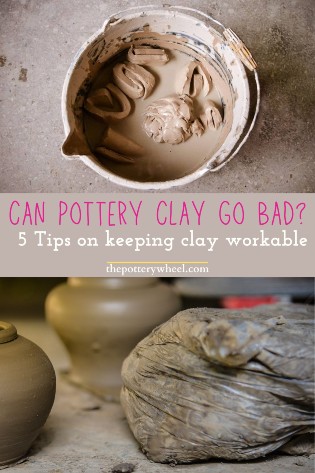
How to Keep Your Pottery Clay in a Good Condition
Although pottery clay lasts indefinitely, you do need to store it well to keep it in shape. Here are some of the things that can go wrong with pottery clay, what you can do to prevent it, and how to fix your clay if you find it has become unusable.
1) Don’t Let the Pottery Clay Dry Out Too Much
Workable pottery clay has a water content of around 20%. Water is in the clay particles, and it’s also between the particles too. It is water in the clay that allows the clay particles to glide over one another and this makes the clay malleable.
However, pottery clay dries out quickly. As soon as you take it out of the plastic bag it will start losing moisture. And even when it’s wrapped in plastic it will lose a small amount of water over time.
Tips on Preventing Clay Drying Out
- It’s best to put your pottery clay in two plastic bags. Seal the bags with a secure tie, and before you seal the bag, press as much air out of the bag as you can. Then store the wrapped clay in a plastic storage box.
- It’s also best not to store clay in a very warm room. This is difficult if you are located somewhere hot, but if there is an option to keep it somewhere cool that will help keep it workable. Even in a plastic bag, clay sitting in direct sunlight will lose water and harden.
What to Do When Your Clay Has Become Dry
Here are a couple of things that I do if I find my clay has become a bit dry and hard.
- Sprinkle some water into the clay bag and then tie the bag closed. Let the clay and the water sit together for a couple of days. I am never too scientific about how much water I add. As a rule of thumb, I might add one cup of water to 6kg of clay, depending on how dry it has become.
- If the clay is moist enough to be sliced, then I slice off a chunk and wrap it in a damp cleaning cloth. I then seal the clay and damp cloth in a plastic bag and leave it overnight. Usually by the next day the clay will have softened up again.
But what do you do if your clay is so dry that it is hard and can’t be sliced? One option is to dry the clay out to the point where it is bone dry, and then rehydrate it.
Rehydrating Your Clay
- To completely dry the clay out, break it into smaller pieces first. Allow the clay to become bone dry, then transfer it into a bucket. You can read more about bone-dry clay here.
- Then cover the clay with water. The clay will quickly break down completely in the water and form a slurry with the consistency of chocolate mousse.
- Rehydrated clay, particularly from a reclaim bucket can be a bit short, which means that it crumbles rather than bending. Some potters add a little bit of vinegar to clay that has been rehydrated. Vinegar is a mild deflocculant, which means that it encourages the clay particles to stick together. As such, vinegar is said to help improve the plasticity of rehydrated clay.
- You can then spread the clay slurry out on a sheet of plywood or a slab of plaster and allow the excess moisture to evaporate.
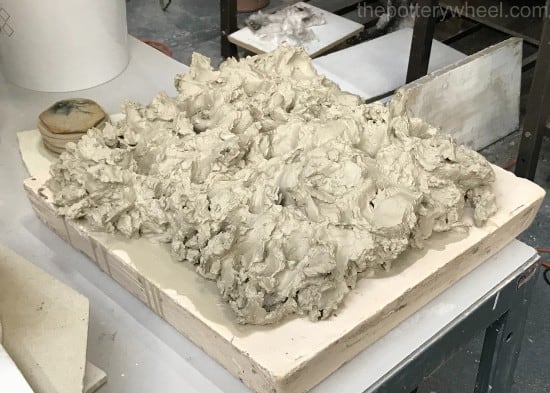
Once the clay has firmed up, you can wedge it and it should be as good as new.
2) Pottery Clay Can Become Moldy
A bag of clay is the perfect environment for mold to grow. Clay contains some organic matter and mold can grow on any organic material under the right conditions. The fact that clay needs to be kept damp, can provide conditions for mold spores to multiply.
But if you open your bag of pottery clay and find that it’s grown mold, does this mean it has gone bad and you need to throw it away? No, not necessarily. There are things you can do to get rid of mold on clay.
Here are some suggestions….
- You can slice it off and use the clay that is left.
- Or you can wedge the mold in. Many potters swear that a bit of mold on their clay makes it more plastic and easier to work with.
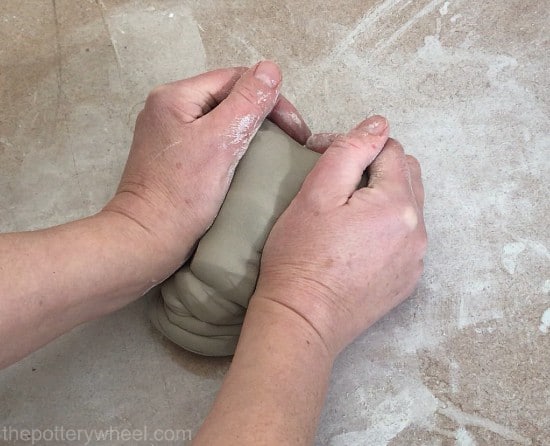
Alternatively, adding a bit of vinegar to your bag of clay can help with the problem. You can read my guide on how to get rid of mold on clay here.
3) What To Do With Clay That Has Been Frozen
Perhaps you keep your clay in the shed or garage where it gets cold in the winter. Or maybe your studio reaches sub-zero temperatures at times. Either way, because it contains water, pottery clay can freeze solid.
Normally clay particles are bonded together in a nice tight structure. But when clay freezes the water turns to ice crystals, and this can push the clay particles apart.
The result is that when your clay thaws out, it will have a slightly strange texture. It’s a little hard to describe, but it feels sort of thick but ‘wobbly’ at the same time.
Plus, you will probably find that big gaps or splits have formed in the middle of the clay. Here is a picture of a block of clay that had frozen and thawed out.
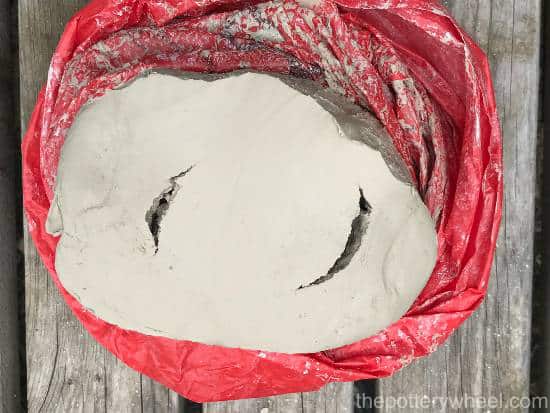
The good news is that although the pottery clay may look bad, once it has thawed out, it can be used again. However, before you use it, you will need to wedge it well. You can read about how to wedge clay here.
Wedging the clay will get rid of those big air pockets in the clay. And it will help to align the clay particles again so that it feels plastic and workable again.
4) Contaminated Pottery Clay
Another issue that can affect the lifespan of your clay is that clay can become contaminated. Generally speaking, if your clay is stored in a clay bag, it won’t come into contact with debris and dirt from the studio.
However, sometimes things can contaminate your clay. Clay is more likely to become contaminated if you are using recycled clay that has been used once and then stored in a reclaim bucket.
All sorts of things can end up in a clay reclaim bucket, this is particularly true if you are working with clay in a school or a shared studio. Everything from pottery tools to paper towels and rubber gloves can end up in the reclaim bin by accident.
Most of the time when you are wedging your clay, you will notice if something rogue has ended up in your clay. But sometimes small contaminants like bits of hair and dirt will go unnoticed.
Usually, this is not a problem. Most of the time bits of unwanted ‘stuff’ will simply be burned away in the kiln as your pottery is fired.
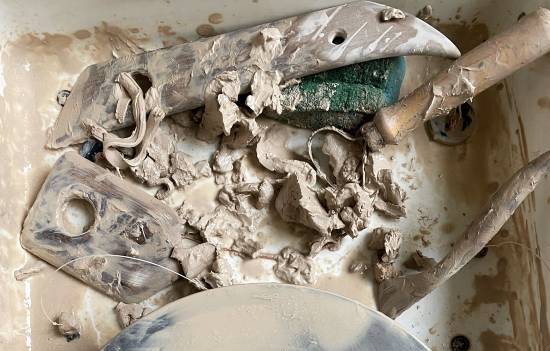
However, some contaminants do cause problems. One such contaminant is pottery plaster.
Why is Plaster in Your Clay a Problem?
Plaster is an extremely useful thing to have in your studio. It makes a good surface to wedge your clay on, or to dry out very wet clay that you want to reclaim. It’s also very handy for making pottery molds. You can read more about pottery plaster here.
The problem with plaster is that it is fragile and crumbly and flakes can break off and end up in your clay body.
Unlike most other bits of debris in your clay, plaster doesn’t simply burn off and disappear when it’s in the kiln.
Very small traces of plaster, such as plaster dust or tiny crumbs of plaster in your clay are unlikely to cause an issue. However, even small chunks of plaster in the clay can cause problems. Here are some things that can happen if your clay is contaminated with plaster…
- The pottery cracks when it’s being fired
- Sections of clay pop off during the firing process
- White blemishes on the surface of the potter as the clay shrinks around the plaster
One solution is to simply avoid having plaster in your pottery workspace. Plaster isn’t essential. There are other absorbent surfaces such as MDF that work well.
However, I find plaster is useful for lots of things, particularly recycling clay and when making pottery molds. My practice is to be vigilant around plaster and keep an eye out for any chance of cross-contamination.
5) Don’t Mix Pottery Clay Bodies
Generally speaking, it’s a good idea to keep different types of clay separate from one another.
There are potters who incorporate mixing different types of clay in their work, to create interesting effects. One such potter is Ewen Henderson, who would sometimes mix porcelain, bone china, and earthenware clay in one piece.
However, different types of clay have different properties. They shrink at different rates when they dry, and they behave differently when they are fired. Some shrink a lot in the kiln, and they can tolerate different temperatures when they are fired.
As a result, mixing different types of clay can have unpredictable results. For example, problems can arise if earthenware clay gets mixed in accidentally with mid or high-fire clay. If this is then fired at a stoneware temperature, the earthenware clay can crack, or melt in the kiln.
So, generally speaking, it’s best to keep different types of clay bodies separate. Unless you are prepared to experiment with some unexpected and sometimes unwanted results.
Why Does Pottery Clay Last So Long Without Going Bad?
Because clay is sold to us in nice neat plastic bags, it’s easy to think that it’s completely manufactured and that it can go off, like a loaf of bread.
Whilst clay that is sold commercially has been refined at a processing plant, the bulk of what clay is made from is thousands of years old.
Clay is mined from the ground, and transported to a processing plant. At the plant, it is milled and purified, and additional ingredients are added to make particular types of clay bodies.
However, the basic clay substance that is extracted from the ground consists of deposits that have formed over a long time.
Pottery clay is rock that has been broken down over a long period of time. Rock is weathered by rain, microbes, and vegetation growth. As a result, it breaks down into smaller particles.
As the rock is broken down, the minerals in the rock are transformed into a mixture of soil, sand, and clay particles.
Clay is made from silicate minerals, such as feldspars which contain silica. Feldspars are the most commonly found minerals in the earth’s crust. When the silicate is weathered by rain and other elements, some components dissolve away.
What is left behind are aluminosilicates, and it is these remaining deposits that make up the clay particles that can be mined from the ground. These clay particles have survived erosion and weathering for thousands of years.
One of the things that will transform clay particles is the heat that they encounter in a kiln. But the everyday conditions in your pottery workspace are not extreme enough to alter or damage the clay platelets in a lasting way.
Final Thoughts
Pottery clay is made of tough stuff. It’s a bit like The Terminator, regardless of what you do with it, generally speaking, it can be revived.
Clay can be dried out by the sun, or frozen in the winter. Or it can be left long enough to become a moldy lump. But pottery clay does not go bad permanently, and with a bit of TLC pottery clay can be made workable again.
The main thing that will change your pottery clay forever, is the process of firing it. Once clay has been fired, it is transformed forever from clay into a ceramic material. But until that point, you should find that pottery clay is pretty resilient and will last indefinitely.



